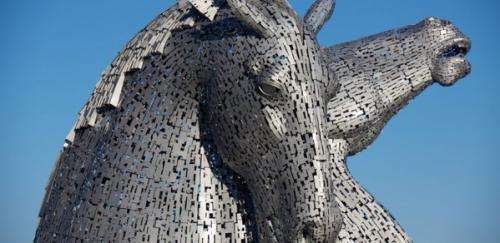Engineering the Kelpies

Recently, Falkirk in Scotland saw the opening of the Kelpies, two thirty metre high horse head sculptures either side of a lock in a new canal extension.
The sculptures are the figurehead of a major redevelopment project called the Helix, changing an industrial wasteland into parkland and reuniting communities in Falkirk and Grangemouth. The finished article is visually stunning, but behind the artwork is eight years of work to take the Kelpies from a concept, to an artist's vision, to an engineered reality. Alumna, Felicity Starr, works as a senior engineer at Atkins. Here she discusses some of the key challenges in leading the development of the engineered solution.
The form of the structure is based on tenth scale maquettes, two three metre high miniature models built from 9,115 individually cut flat steel plates welded together over a wire frame by the sculptor, Andy Scott. The mosaic effect created by the flow of the plates and the view through the openings capture the horses as if in motion. The challenge was to take these scale models and translate them into an engineered solution, which had the structural strength required, could be suitably detailed for manufacture and transportation, and would stand as a monument for years to come, and yet retain the sculptor's vision.
Working closely with the artist at every stage of the design was key. The internal structure design began with discussions on the muscle groups of a horse's head. The final form, with columns creating two stiff triangular-based structures at the front and back of the horse's head interconnected by braced flat frames, provides an efficient, strong structure, but also maintains a clear cathedral-like space internally and keeps the structural density low in key areas. This approach led to the creation of an internal structure which was a sculpture in itself.
A major challenge was in translating the individual plates produced by the artist into manufacturable and supportable panels. It quickly became clear that using individual plates as the artist had envisaged was unworkable, the support positions required per plate lead to a dense structure, blocking light effects through the skin. The flat maquette plates relied on angles between plates to achieve the curved surface. Grouping the panels greatly reduced the required number of support positions but then each panel had to be bent in multiple planes to get back to the curved surface. To manufacture curved plates involved expensive processes. A solution was proposed which used individual support points on the sculpture to pull the panels from flat profiled plates to the required shape using lockable blind fasteners.
The result was 928 unique stainless steel panels, each one based on scanned data of the artist's maquettes and then optimised using finite element analysis, first to create flattened panels for the laser cutter, and then to ensure that the panel could be pulled back from a flat plate to the required shape using the discrete support positions. Each panel has been carefully designed to reduce pull forces, reduce error in final positioning and to ensure the panel had the strength to withstand high and fluctuating wind loads, as well as to maintain the original visual impact. The majority of the resulting panels were site fixed onto the erected frame, the ease of assembly is a testimony to the engineered solution.
Engineering the Kelpies was a real privilege. The team created something which not only we can be proud of, but is a source of pride for the community and a symbol for regeneration for the area. The engineering behind the sculpture was challenging, with many complex issues to resolve, but the finished product is not just a beautiful piece of artwork, it's a showcase of innovative structural and mechanical engineering.
A timelapse short film of the Kelpies and their construction can be viewed here.
Provided by University of Cambridge




















